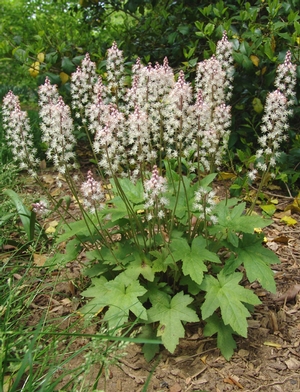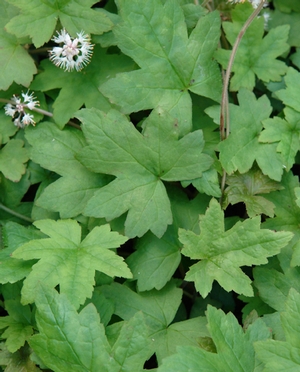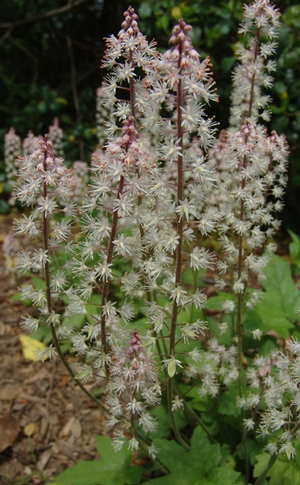Tiarella cordifolia var. collina 'Oakleaf'
Common: foamflowerTiarella cordifolia var. collina 'Oakleaf' LP32 - 32 per flat
- Height: 10"-12"
- Spread: 12"-18"
- Spacing: 12"
- Hardiness Zone(s): 4-8


Tiarella cordifolia var. collina 'Oakleaf' LP32 - 32 per flat


One of the first and still one of the best of the new generation of foamflowers. A very long blooming, clumping plant with wonderfully shaped leaves, light pink flowers and bronze new spring growth. Brilliant burgundy winter color. A shared introduction from the University of Delaware, the Brandywine Conservancy, and Dunvegan Nursery.
Prefers moist, rich, organic, well-drained soils in full to part shade. Do not let soil dry out. Stoloniferous, but this variety spreads more slowly than others. Propagate by spring division. Makes an excellent groundcover or edging for shady or naturalized areas.
Tiarella cordifolia var collina ‘Oakleaf’ is a shared introduction from the University of Delaware, the Brandywine Conservancy, and Dunvegan Nursery. It is a very long-blooming, clumping plant with wonderfully shaped leaves, light pink flowers, and bronze new spring growth. Growing up to 12” tall or 18” tall while in flower, ‘Oakleaf’ is especially noted for its brilliant burgundy winter color. Considered one of the best original introductions of Tiarella to the market, ‘Oakleaf’ was selected for its heat and humidity resistance, deep leaf lobing, and bright green coloring.
Tiarella cordifolia is found in shaded forests, swamps, and wetland margins from Ontario to Minnesota to Tennessee to Georgia. The variant species Tiarella cordifolia var collina looks very similar to the straight species but is found throughout the North Carolina Piedmont. Preferring consistently moist, humus rich soil, foamflower does not like soil drying out or sitting in saturated soils during winter. With no serious pest or disease issues, T. cordifolia does best if planted en masse and spreads rapidly by runners.
Foamflower is a powerful and natural partner in a shade garden embracing spring ephemerals and graceful sedges. We love weaving it along border fronts, naturalistic plantings, shaded rock gardens, or in woodland gardens. A fresh groundcover, even as other items in the woodland garden begin to look tired in the summer, Tiarella cordifolia provides texture and color all year long. The foliage is astringent, usually deterring rabbits and deer from grazing unless they are extremely hungry. Early-season pollinators visit foamflower while other plants are still waking up in the spring.